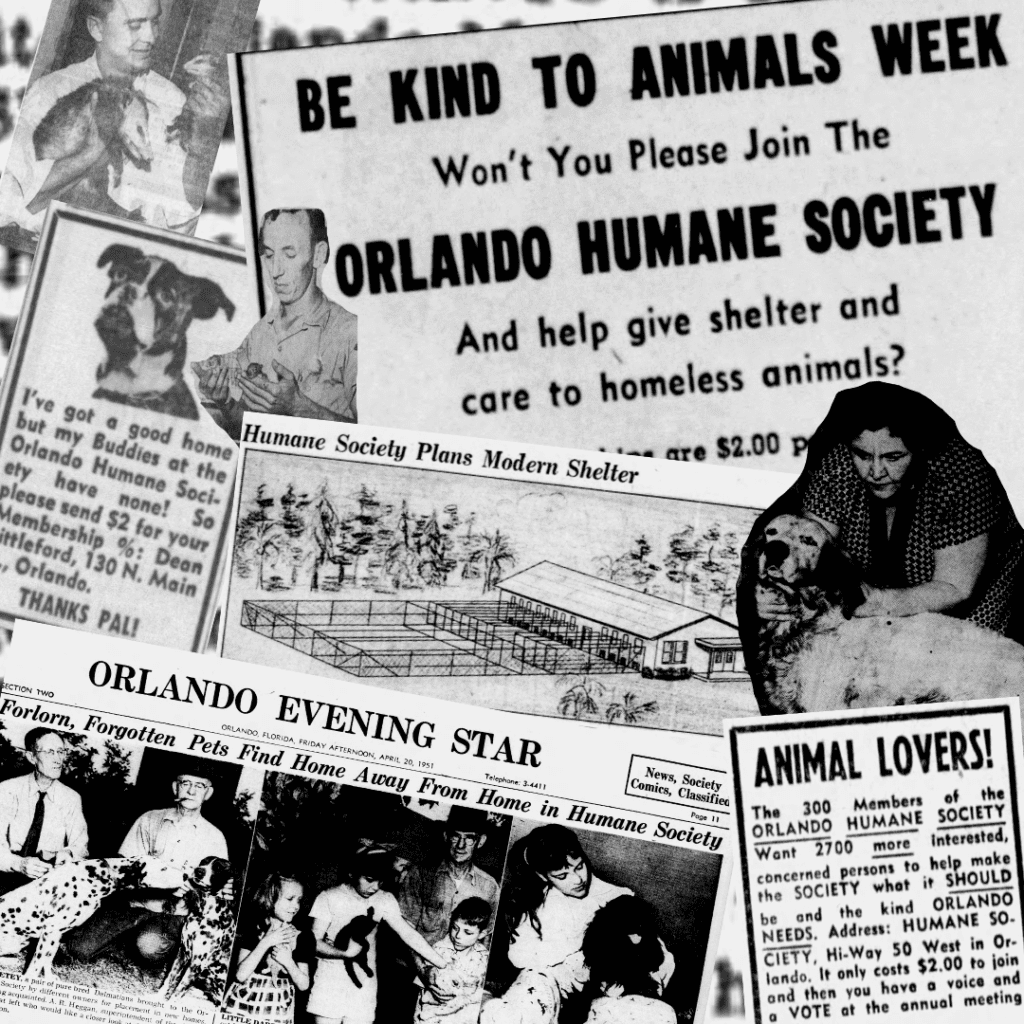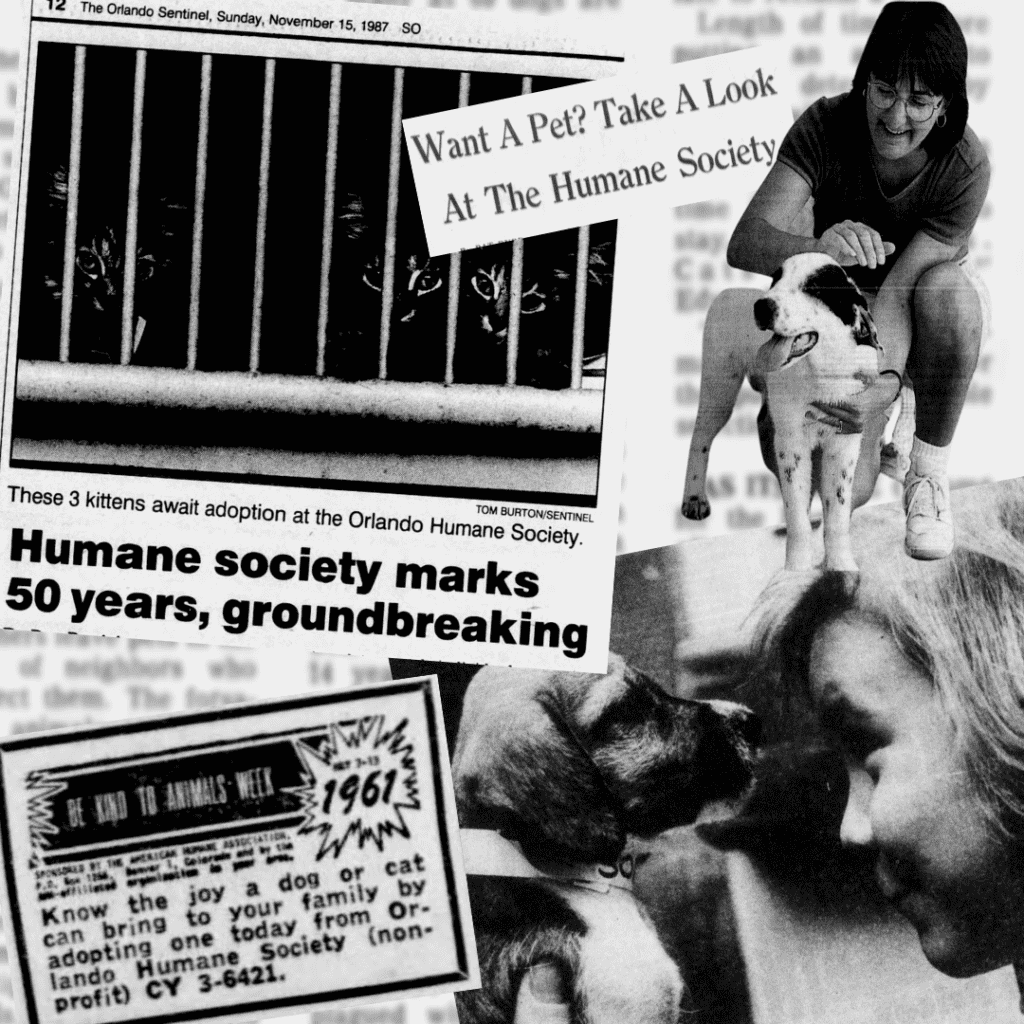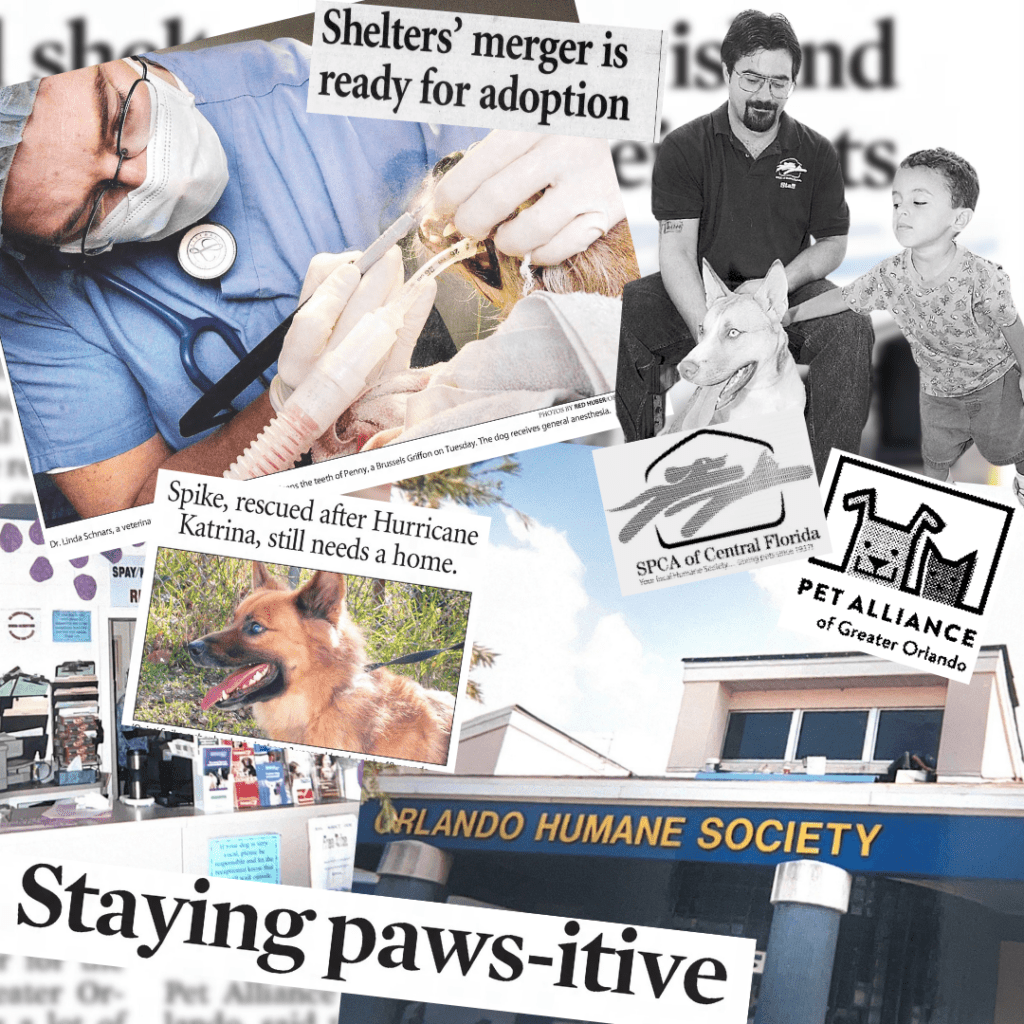


Founded in 1937 when a group of concerned citizens began meeting in Downtown Orlando, Pet Alliance, then known as the Orlando Humane Society, originally had four goals. “(1) to inculcate the spirit of kindness and mercy, (2) to provide effective means for the prevention of cruelty to children and animals through the enforcement of laws, (3) to care for unfortunates and (4) to disseminate education pertaining to these objects.”
Animal welfare soon shifted to the forefront of the organization’s mission. Without a proper building to call our own and relying only on membership fees and donations, a team of dedicated volunteers began caring for animals in their private residences. Our foster program is as old as we are! Even our first employee, hired in 1947, kept kennels in his home.
The organization’s first brick and mortar shelter was developed in the 1950’s, located on Barry Street in west Orlando. The 50’s also saw the adoption of our ongoing policy to spay and neuter adopted pets. However, with no on-site veterinary services, adopters were given a voucher to get their animal sterilized at an outside clinic post-adoption.
At this point in time, the Society’s advocacy was needed beyond canine and feline causes. Their many adventures included providing feed for starving cattle, the humane management of an abundance of pigeons in Downtown Orlando, and speaking out against a Florida senator giving baby alligators as gifts to his pages. A variety of species could also be found in the Barry Street shelter at that time. A newspaper article stated that in 1951, Orlando Humane “cared for 7,000 cats and dogs, as well as goats, monkeys, raccoons, opossums, a calf, and even a pet skunk.”
The Society, constantly in need of more space, broke ground to build a larger facility adjacent to the existing shelter in 1960. In 1961, the shelter saw the intake of a staggering 14,000 animals! The late 60’s also saw the introduction of the Society’s Humane Education programs for the community, emphasizing the importance of responsible pet ownership.
Welfare causes that Orlando Humane supported during this time included leash law legislation, changes to the use of live animals for experimentation in schools, and a law that prohibited the sale or giving away of young rabbits or fowl as Easter gifts.
Orlando Humane Society operated as the sole animal shelter for the area until the 1970s, when Orange County built its own municipally run shelter. By that time, the Society was seeing intakes of over 25,000 animals a year and operated with only 7 employees. With a rising number of animals to care for, the Society was at the mercy of their shelter space and staffing limitations. Additionally, there were still no on-site veterinarians, meaning animals who came into the shelter with medical issues were unfortunately not considered adoption candidates. Live release rates were 17-20%, as opposed to the 98% figure you see in our organization today.
The early 80’s saw an expansion of the Barry Street shelter, allowing for the housing of an additional 100 animals. With the county now running its municipal shelter and animal services program, the Society was typically only admitting cats and dogs. Reports claimed they occasionally assisted with other species, including a Burmese python who got loose in the employee breakroom overnight!
Despite the expansion, it was clear that a larger, more modern facility would soon be needed. In 1987, The Society celebrated its 50th birthday with a groundbreaking ceremony for the building that many of you would come to know at 2727 Americana Boulevard, now Conroy Road.
As Orlando Humane Society approached the new millennium, it would face its most exciting improvements yet.
With the hiring of the organization’s first on-site veterinarian in the 90’s, animals were finally able to be spayed/neutered onsite. Additionally, the organization’s first public veterinary clinic was opened in 1993. In the past 21 years, more than 200,000 spay/neuter surgeries have been performed by our organization’s veterinarians. Additionally, the opening of the new, much larger Conroy Road facility meant we could assist other shelters who were experiencing overcrowding or disaster, marking the beginnings of our transport efforts.
The 2000’s began with a massive merger and a new name. In 2001, Orlando Humane Society merged with Seminole Humane Society to form the SPCA of Central Florida. After a massive renovation, Seminole Humane’s shelter became our current Sanford location. The Conroy Road shelter also underwent a major expansion. The shelterless Osceola Humane was incorporated in 2002.
Public outreach continued to expand, including the launches of programs like AniMeals on Wheels to bring pet food to low income seniors. The organization’s transfer efforts proved to be most valuable in the wake of the natural disasters of the time. Most notably, we were able to provide shelter for almost 500 pets who were displaced by Hurricane Katrina.
In 2014, the organization was rebranded to the Pet Alliance of Greater Orlando. This new moniker came with goals of continuing to increase the live release rate of shelter pets and a focus on engaging the entire community in the responsibility of caring for their own pets. From 2014 to 2020, the live release rate would increase from 70% to more than 98%. Progress for Orlando’s animals continued with the establishment of our Community Cat Initiative in 2017 to advance our Trap Neuter Vaccinate Return efforts, and the opening of the Alafaya Clinic in 2018.
Over the past 86 years, Pet Alliance staff and volunteers have cared for more than 750,000 animals, a feat only made possible with the support of our amazing community.